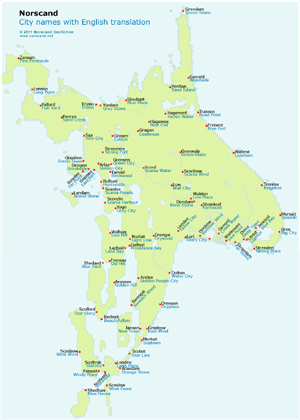Norscand Language (by George).
 Introduction. The inhabitants of Norscand speak Norscandian (Iom Norscande), a relatively easy and widespread language. This language has multiple varieties, which differ at such a scale that people from the southern districts of Garand wouldn't immediately understand someone from Lostrand. However, the base form, Standard Norscandian (Iomsand Norscande), is understood by the majority of the Norscandians and is used for television and radio broadcasts, documents, signs and school. Introduction. The inhabitants of Norscand speak Norscandian (Iom Norscande), a relatively easy and widespread language. This language has multiple varieties, which differ at such a scale that people from the southern districts of Garand wouldn't immediately understand someone from Lostrand. However, the base form, Standard Norscandian (Iomsand Norscande), is understood by the majority of the Norscandians and is used for television and radio broadcasts, documents, signs and school.
This Standard Norscandian is more or less native to the Scansey region, which makes sense because the capital is located in that area. Schools are obliged by law to teach using Standard Norscandian.
 Overview of the language itself. Norscandian is, like English and most contemporary Indo-European languages an lightly fusional to analytic language (that is, with little or no inflections of nouns and verbs) and a syllable pattern similar to English. Overview of the language itself. Norscandian is, like English and most contemporary Indo-European languages an lightly fusional to analytic language (that is, with little or no inflections of nouns and verbs) and a syllable pattern similar to English.
Norscandian differs from English in the aspect of sentence order. A normal English sentence abides the order Subject-Verb-Object, whereas Norscandian makes use of the so-called SOV-order, that is, Subject-Object-Verb. Compare:
He kicks the dog. (English order)
I oste dantait. "He the dog kicks." (Norscandian order)
Norscandian has no inflection of verbs by person or number: verbs stay the same, even when in English suffixes are added: He walks has no Norscandian equivalent. Norscandian doesn't have articles either, but a Norscandian can indicate whether or not the noun in his sentence is definite or not by means of a sound change: The first vowel in the word changes, an aspect which some west-African languages have too.
 Verbs. Norscandian has a tense inventory that is really different from English, containing five verb tenses: a present, a near-present, a past, a future and a habitual. The present is used when indicating something that's happening now or going to happen very soon (say 5 minutes at max). It is constructed using the base form of the verb. The near-present is used when indicating something that's either happened not that long ago, or something which has consequences for the present. It is constructed by adding de- before the verb. Verbs. Norscandian has a tense inventory that is really different from English, containing five verb tenses: a present, a near-present, a past, a future and a habitual. The present is used when indicating something that's happening now or going to happen very soon (say 5 minutes at max). It is constructed using the base form of the verb. The near-present is used when indicating something that's either happened not that long ago, or something which has consequences for the present. It is constructed by adding de- before the verb.
The past is used for events that happened longer ago than the near-present, and that don't have (deep) consequences for the present. It's constructed by adding a- before the verb. The future is constructed by adding -sait after the verb.
The habitual is used for repeated actions, behavior or reoccurring patterns. It's only used in written documents, as it's considered archaic and redundant. It can be constructed by either adding -en or -on behind the verb.
 Small dictionary.
This dictionary gives a small list of frequently used Norscandian words on the maps. Small dictionary.
This dictionary gives a small list of frequently used Norscandian words on the maps.
Aiskai-Expressway
Aistras-Expressway
Aran-Orange
Ard-Yard
Are-Gold
Bassin-Laht
Bate-Cape
Boil-Bay
Bonk-Knob
Bron-Bridge
Center-Central
Centra-Centre
Cod-Cave
Dale-Channel
Den-Place
Dim-Mid
Din-Deep
Don-Pond
Dort-Village
Dravel-Boulevard
Eides-Palace
Ent-Town
Ep(p)en-Upper
Erport-Airport
Ert-Lane
Ettl-Settlement
Far-Avenue
Fjun-Dune
Fora-Fork
Fren-Old
Fug-Gulf
Gait-Creek
Gen-Key
Gentam-Magenta
Gid-Ridge
Gost-Coast
Gras-East
Gren-Green
Grend-Great
Gros-Big
Haed-Head
Hage-New
Halle-Hall
Hally-Valley
Haver-Harbor
Hite-White
|
Hof-Court
Hoh-High
Host-House
Jeik-Cyan
Kai-Drive
Kai-Prospect
Kast-Castle
Kod-Mount
Kor-Rock
Krest-Crest
Lack-Black
Lann-Island
Laht-Bay
Laren-Lower
Larotil-Litoral
Lax-City, town
Len-Yellow
Len-City, town
Let-Left
Letvoi-Violet
Linn-Town
Lod-Mall
Lon-Long
Low-Coast
Lowshal-Shallow
Luw-Wall
Men-Fort, Burg
Mer-Sea
Moll-Mall
Nail-Plain
Netlan-Tunnel
Njokan-Canyon
Nor-North
Ordanter-Waterfall
Ort-Short
Pereid-Parade
Pit-Pit
Rand-Beach
Rau-Street
Ref-Cut
Renni-Inner
Reso-Rose
Riffer-Ferry
Riht-Right
Ring-Ring
|
Rir-River
Rod-Red
Rof-Ford
Rosh-Shore
Rund-Round
Sait-Side
San-Peninsula
Sax-Hill
Scas-West
Seik-Lake
Sen-Point
Serv-Reservoir
Shed-Blue
Site-Side
Slad-Strait
Stra(n)-Far
Sud-South
Talda-Delta
Teur-Tower
Til-Small
Tras-Path
Tras-Road
Tred-Damb
Troit-City
Uot-Out
Uotti-Outter
Urs-Spur
Vag-Way
Verog-Groove
Wam-Swamp
Wex-End
Wins-Wing
Wol-Low
Yog-Grey
0-Hu 0-Hun
1-Sa 1st-Shi
2-Un 2nd-Lin
3-Ma 3d-Mait
4-De 4th-Deit
5-Qa 5th-Qan
6-Tan 6th-Tannen
7-Scei 7th-Scennen
8-Rai 8th-Rannen
9-Fa 9th-Han
10-Us 10th-Ust
|
 Back to the "Behind the maps" section Back to the "Behind the maps" section
| 
